As of 2025, video makes up nearly 82% of global internet traffic, with monetization platforms enabling creators to earn billions through ads, subscriptions, and pay-per-view.
Platforms like YouTube, Vimeo, Flicknexs, and Webnexs support AVOD, SVOD, and TVOD models for creators and businesses worldwide.
With video ads growing 46% and online viewership up 72% last year, now is the perfect time to turn your content into income.
Whether you’re an established creator or just starting out, the right platform can maximize your revenue opportunities.
This guide lists the top 10 video monetization platforms in 2025, compares their features, and explains how creators can generate revenue via AVOD, SVOD, TVOD, and membership models.
What is Video Monetization?
Video monetization generated over $75 billion globally in 2024 and is expected to grow by 25% in 2025, as more creators and brands leverage online video for revenue. To understand how creators can implement these strategies, see How Video Monetization Works for a step-by-step guide.
Video monetization is the process of earning revenue from video content. This can include ads, subscriptions, pay-per-view, memberships, or crowdfunding.
Stat: The market of video monetization globally is supposed to be worth around $80 billion by 2025, which depicts an annual growth rate of 15% and over.
What are Video Monetization Platforms?
Video monetization platforms are online tools that enable content creators to earn revenue from their video content through advertising, subscriptions, pay-per-view, and live streaming. In 2025, video monetization is expected to generate over $90 billion globally, highlighting its growing significance. Popular platforms include YouTube, Vimeo OTT, Patreon, Flicknexs, and Webnexs, each offering unique monetization options for creators of all sizes.
How do video monetization platforms generate revenue in 2025?
Video monetization platforms generate billions in revenue globally each year. In 2025, creators can earn through advertising, subscriptions, pay-per-view, and membership models, enabling multiple income streams while scaling their audience.
Advertising-Based Video on Demand (AVOD)
Description:
- Platforms display ads during videos (pre-roll, mid-roll, post-roll).
- Revenue depends on impressions, clicks, and engagement rates.
- Ideal for creators with large audiences.
Example Stats (if available):
- YouTube AVOD revenue grew 25% YoY in 2024.
Subscription Video on Demand (SVOD)
Description:
- Users pay a recurring fee (monthly/annual) to access content.
- Provides predictable revenue for creators and platforms.
- Popular for educational content and premium shows.
Example Stats:
- SVOD platforms like Netflix and Flicknexs generated $60B+ globally in 2024.
Transactional Video on Demand (TVOD )
Description:
- Viewers pay per content piece (movie, episode, event).
- Suitable for one-time releases or premium content.
- Platforms keep a share, the rest goes to the creator.
Example:
- Pay-per-view events, such as live sports or concerts, can earn creators up to $50K per event.
Stat: 85% of video marketers say the data provided by monetization platforms is crucial for their income.
Why Video Monetization is Important in 2025
Why is Video Content Increasingly Significant for Revenue in 2025?
In 2025, video content drives over 82% of global internet traffic, making it the most consumed online medium. The surge in video viewership across websites, apps, and OTT platforms has turned video monetization into a multi-billion-dollar industry.
For creators and businesses, leveraging this trend is crucial. Platforms that support AVOD, SVOD, TVOD, or hybrid models allow content owners to generate consistent revenue, reach global audiences, and diversify income streams. Choosing the right video monetization platform ensures maximum engagement and profitability in this rapidly growing market.
Stat: It has been predicted that, by 2025, video will be responsible for more than 82% of all internet traffic, which means it will be the most accessed type of online content.
Key Benefits of Video Monetization in 2025
1. How does video monetization help creators earn revenue regularly?
Video monetization allows you to earn money while viewers watch your content, providing a scalable and reliable income source.
Stat: Creators who enable monetization often report a stable monthly income they can consistently rely on.
2. How can video platforms help creators reach a global audience?
By distributing content across regions and leveraging tools like subtitles, your videos can reach audiences worldwide.
Stat: Videos with subtitles receive 3x more views from international audiences compared to single-language videos.
3. How can creators diversify income streams with video monetization?
Platforms support multiple revenue models—AVOD, SVOD, TVOD, and crowdfunding—so you can generate income through your preferred channels and reduce business risk.
Stat: 74% of creators using hybrid models report higher profits than those relying on a single monetization method.
4. How does data analytics improve video performance and revenue?
Video platforms provide analytics to help you extract insights, optimize content, and boost engagement, turning data into actionable decisions.
Stat: Over 80% of data-driven creators see their revenue increase by 30% or more.
5. How does video monetization support building a sustainable video business?
Using the right platform and a strategic plan, creators can establish a long-term, sustainable video business with recurring revenue and growth potential.
Using the right platform and a strategic plan, creators can establish a long-term, sustainable video business with recurring revenue and growth potential.
Stat: 60% of small creators but more and more scalable operations a year after they start monetizing.
Stat: 1 in 3 creators that monopolize platforms with ad sales can access a revenue that is up to three times larger than before.
How Video Monetization Works in 2025
Video monetization involves uploading content, selecting a revenue model, distributing videos, tracking analytics, and collecting payments. Key metrics like watch time, engagement, and revenue reports help creators optimize earnings.
What is the Step-by-Step Video Monetization Process?
- Upload Your Video Content: Post your videos to a trusted video monetization platform.
- Choose a Monetization Model: Select your preferred approach, such as:
- AVOD: Ad-Based Video on Demand
- SVOD: Subscription Video on Demand
- TVOD: Transactional or Premium Video on Demand
- Hybrid models combining multiple streams
- Distribute Your Content: Share your videos via your website, apps, or third-party platforms to reach a wider audience.
- Track Analytics: Monitor performance metrics like views, watch time, and engagement. Use this data to optimize revenue.
- Collect Payments: Use integrated payment gateways to receive income from subscriptions, transactions, or ad revenue.
Key Stat for Authority:
70% of creators using hybrid monetization methods see significant revenue growth within six months.
| Step | Action | Purpose |
|---|---|---|
| 1 | Upload video | Make content available on the platform |
| 2 | Select monetization model | Decide revenue strategy |
| 3 | Distribute content | Reach wider audience |
| 4 | Track analytics | Optimize revenue |
| 5 | Collect payments | Receive income securely |
Which Analytics and Metrics Matter for Video Monetization?
To maximize earnings in 2025, creators must understand viewer behavior. Platforms provide analytics tools to monitor key metrics, including:
| Metric | Why It Matters |
|---|---|
| Watch Time | Measures engagement; longer views → higher ad revenue |
| Engagement Rate | Shows how viewers interact with content (likes, shares, comments) |
| Viewer Demographics | Helps target content and ads effectively |
| Revenue Reports | Tracks earnings per model and overall profitability |
Stat: Videos with higher average watch times not only have higher average revenues but also allow for up to 40% gains in the case of both AVOD and SVOD models.
Top Video Monetization Models in 2025
In 2025, AVOD (Ad-Based Video on Demand) accounts for 45% of total video revenue, SVOD (Subscription Video on Demand) contributes 35%, TVOD/PVOD (Transactional & Premium Video on Demand) makes up 15%, and Hybrid models cover 5%. Each model offers unique opportunities for creators depending on audience and content type.
What is AVOD and how does it generate revenue?
- AVOD allows users to watch videos for free while platforms generate revenue through advertisements. Brands pay to display ads, earning creators revenue per view or click.
- Revenue Share (2025 Estimate): 45% of total video monetization revenue globally.
- Key Features / Benefits:
- Free access for viewers → higher audience reach
- Monetization per ad impression or click
- Works well for large-scale content distribution
What is SVOD and why do creators choose it?
- SVOD is a subscription-based model where users pay recurring fees for premium content. Creators earn predictable, recurring revenue, and platforms often provide analytics to optimize retention.
- Revenue Share (2025 Estimate): 35% of total video monetization revenue.
- Key Features / Benefits:
- Predictable monthly or yearly income
- Offers premium or ad-free content
- Works for niche audiences and high-value content
How does TVOD work for creators?
- TVOD allows users to pay per video or event, while PVOD provides early access to premium content at a higher price. Creators earn revenue per transaction, making it ideal for exclusive or limited releases.”
- Revenue Share (2025 Estimate): 15% of global video revenue.
- Key Features / Benefits:
- Monetize exclusive content on-demand
- High revenue per transaction for premium videos
- Suitable for movies, live events, or special releases
What is hybrid video monetization and how does it work?
- Hybrid models combine two or more monetization strategies, like AVOD + SVOD or TVOD + AVOD, allowing creators to diversify revenue streams. This approach maximizes earnings while catering to different audience segments.”
- Revenue Share (2025 Estimate): 5% of video monetization revenue.
- Key Features / Benefits:
- Multiple revenue streams in one platform
- Flexibility to offer free and premium content simultaneously
- Ideal for creators targeting both mass audiences and paying subscribers
Suggested Table for Clarity
| Model | Revenue Share (2025) | Description | Ideal For |
|---|---|---|---|
| AVOD | 45% | Ad-based free access | Broad audiences, high-traffic channels |
| SVOD | 35% | Subscription-based premium content | Niche audiences, premium content |
| TVOD/PVOD | 15% | Pay-per-view or early access | Exclusive releases, events |
| Hybrid | 5% | Combination of AVOD, SVOD, or TVOD | Creators seeking multiple revenue streams |
Comparison of Top 10 Video Monetization Platforms
| Platform | Monetization Models | Best For | Key Features | Pros | Cons |
|---|---|---|---|---|---|
| Flicknexs | AVOD, SVOD, TVOD | Businesses of all sizes | Library management, region-based pricing, multi-currency, ads, live streaming, PPV, subtitles | Multiple revenue options, intuitive UI | Limited 3rd-party integrations, some customization restrictions |
| Webnexs VOD | SVOD, Sponsored, Paid Videos | OTT brands, enterprises | DRM, scalable streaming, custom VOD apps, branded websites & apps | Strong customer support, customizable | Steep learning curve, limited free features |
| Vimeo OTT | SVOD | Independent creators | Custom OTT apps, analytics, branded streaming | Easy to set up, secure, CRM/email integration | Not for large-scale streaming, costly |
| Wistia | Lead-gen & marketing focus (not full AVOD/SVOD) | Businesses & marketers | Video hosting, lead generation tools, customizable player, analytics | Great for marketing, strong CRM/email integrations | Not for entertainment streaming, expensive |
| Brightcove | AVOD, SVOD | Enterprises & broadcasters | Cloud hosting, enterprise security, advanced analytics | Scalable, excellent video delivery | Expensive, complex pricing |
| Kaltura | AVOD, SVOD, Live, Interactive | Enterprises, Education | Open-source, customizable, interactive tools, live/on-demand | High flexibility, strong dev community | High learning curve, pricing complexity |
| JW Player | AVOD (ads) | Publishers, ad-focused creators | Advanced player, ad monetization, fast loading, analytics | Great for ads, lightweight & fast | Limited SVOD/TVOD, basic customization |
| Uscreen | SVOD | Creators, educators | SVOD, course selling, community tools | Easy setup, strong community-building | Expensive for small creators, limited live streaming |
| Dacast | AVOD, SVOD, PPV | Live event streaming | PPV, live streaming, cloud delivery | Strong for live events, simple setup | Limited features, fewer integrations |
| Muvi | AVOD, SVOD, TVOD | Enterprises, large-scale OTT | End-to-end OTT, multi-device, fully configurable | Enterprise-ready, complete OTT solution | Expensive, complex for beginners |
Top Video Monetization Platforms in 2025
In 2025, these 10 video monetization platforms offer creators a range of revenue options including ads, subscriptions, pay-per-view, and crowdfunding. Each platform is analyzed for features, pros, and cons to help you choose the best fit.
1. Flicknexs
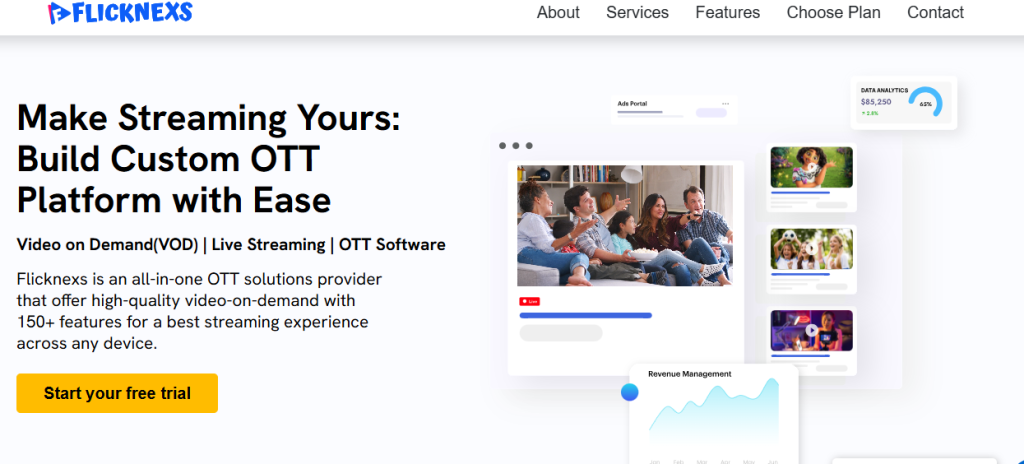
Flicknexs is a full-service over-the-top media platform that not only offers electronic transactions of monetization through avenues such as AVOD, SVOD, and TVOD, it also is an enterprise-level solution for corporates to build and manage their video content with customizable branding and money-making strategies.
Features:
- Library Management for easy content organization
- Filter Options for Categories and Episodes for better navigation
- Region-Based Pricing for localized market conditions
- Multi-Currency Support for global transactions
- Language Translation for diverse audiences
- Time Slot Ads for targeted advertising
- Advertisements for additional revenue
- Live Streaming for real-time events
- Partners for extended data offerings
- Multi-Profile Support for individual user settings
- Subtitles for the inclusive in multiple languages
- Subscription and Pay-Per-View for alternative monetization
- Comments for user engagement
- Transcoding for videos playable on any device
- Time Zone-Based Video Scheduling for the adapted distribution of the contents
Pros:
- Diverse ways to earn money
- The user interface is very intuitive
- Appropriate for all sizes of businesses
Cons:
- Not many choices for third-party application integrations
- There are some restrictions on the customization for the less experienced user
2. Webnexs VOD
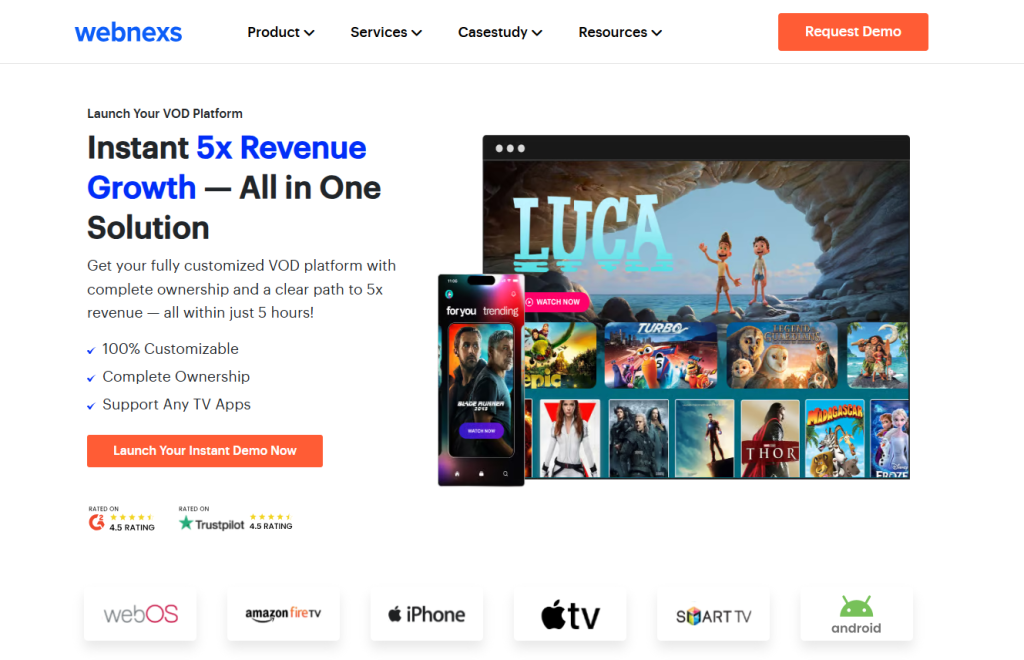
Webnexs VOD is a web-based platform designed to let users build their video-on-demand services from the infrastructure to the front end.
It supports various features that cater to any type of content and distribution need.
The server-based platform is also highly customizable, so users can leverage their branding images while deriving profits from sponsored and paid videos.
Features:
- Custom VOD platform
- DRM – security is committed to safeguarding content
- Streaming solutions – potentially turning into scalable ones
- Monetization based on a paid subscription service
Pros:
- OTT platforms with well-known brands are in for a feast
- As if websites and applications are pieces that can blend with at the same time
- Strong customer support
Cons:
- Beginners will face difficulty learning the ins and outs of the software
- Still, the number of free features is quite limited, and the best ones are not free
3. Vimeo OTT
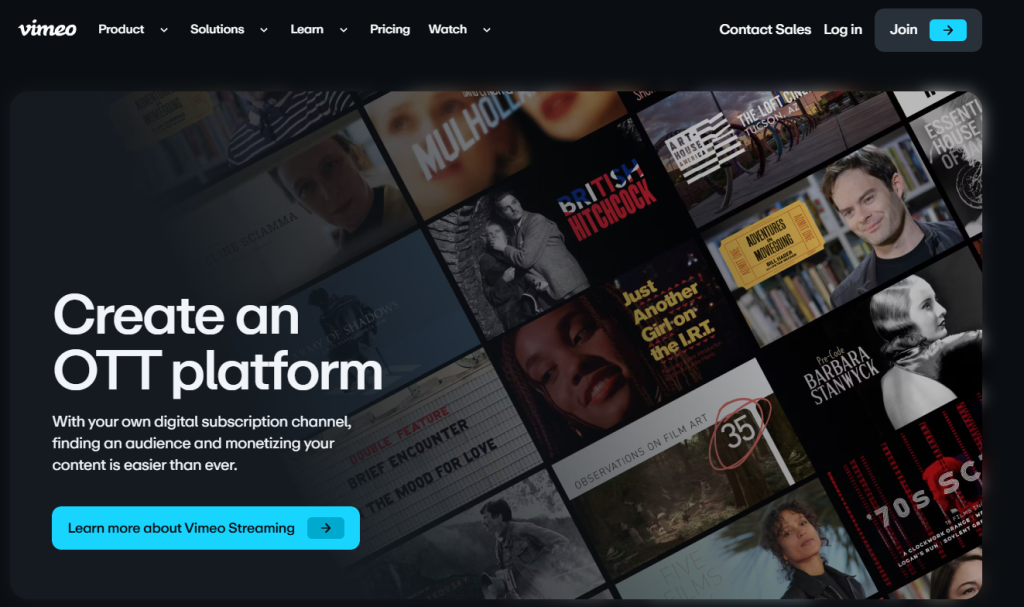
Vimeo OTT, on the whole, targets a customer base who would like to create streaming video apps as per a subscription-based model. Independent content makers, among others, can launch their own brands on this platform.
Features:
- Subscription-based monetization
- Custom-branded OTT apps
- Advanced analytics for video performance
Pros:
- Installation is quite easy to carry out and the security of the platform is guaranteed
- Integrates well with email marketing and CRMs
- Great for creating branded video experiences
Cons:
- Not suited for large-scale streaming or entertainment content
- More expensive compared to other video hosting platforms
4. Wistia
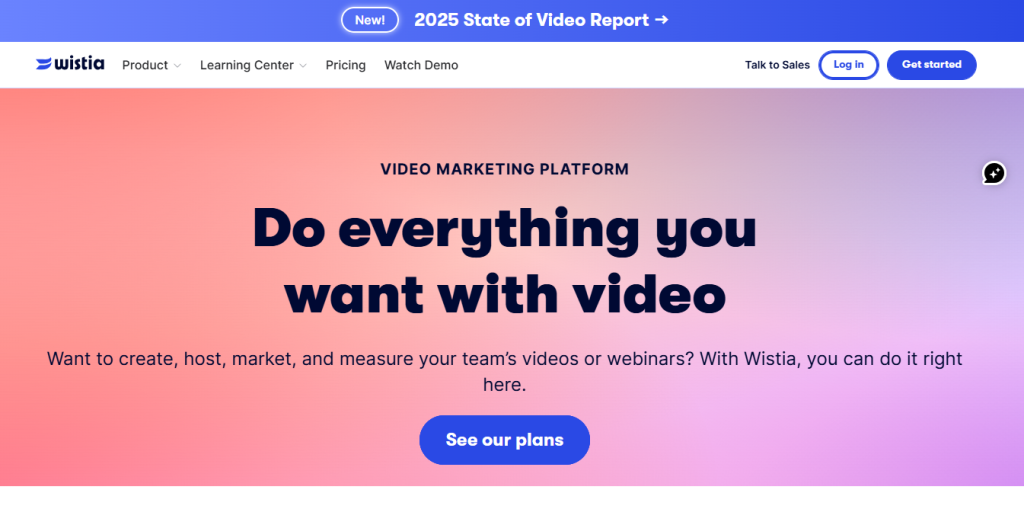
With Wistia, many companies are provided not only with a video hosting solution, they also get the necessary business tools for successful video marketing. The feature list includes powerful analytics, lead generation tools, and players that are customizable to allow users to use it in the best way to increase engagement.
Features:
- Video hosting with lead generation tools
- Customizable video player
- Detailed video analytics
Pros:
- Great for video marketing and business-related content
- Works nicely with email marketing and CRMs
- Best for making brand-tailored video experiences
Cons:
- It’s not suitable for mass streams or content from the entertainment industry
- In comparison to other platforms, it is more expensive
5. Brightcove
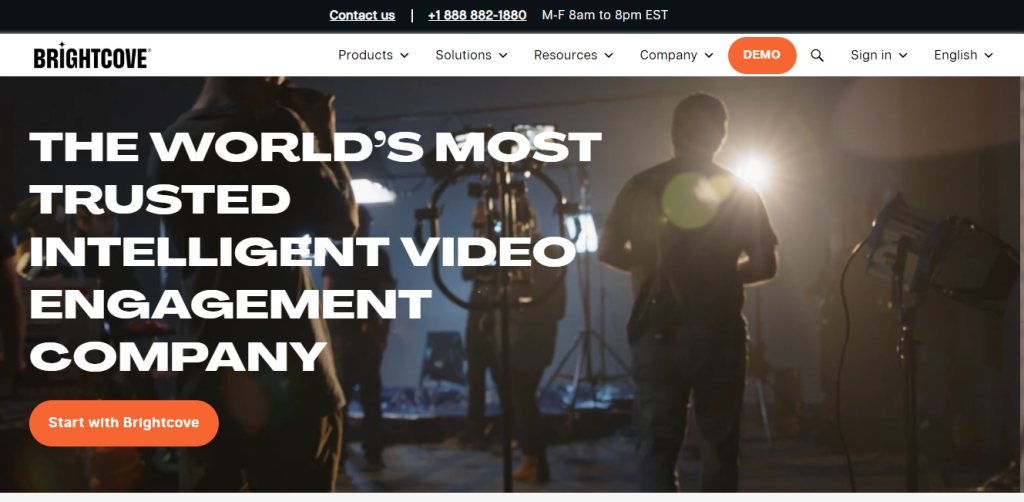
Brightcove is a first-grade video storage and monetization platform. It is perfect for companies that acquire high-volume video content. It provides them with the ability to operate it on the cloud, it has a reliable, secure storage system, and offers excellent monitoring tools for broadcasters.
Features:
- Cloud-based video hosting
- Advanced monetization options (SVOD, AVOD)
- Enterprise-level security features
- Comprehensive analytics dashboard
Pros:
- Ideal for large organizations and broadcasters
- Scalable with enterprise-level features
- Excellent video delivery performance
Cons:
- Expensive for small content creators
- Complex pricing structure
6. Kaltura
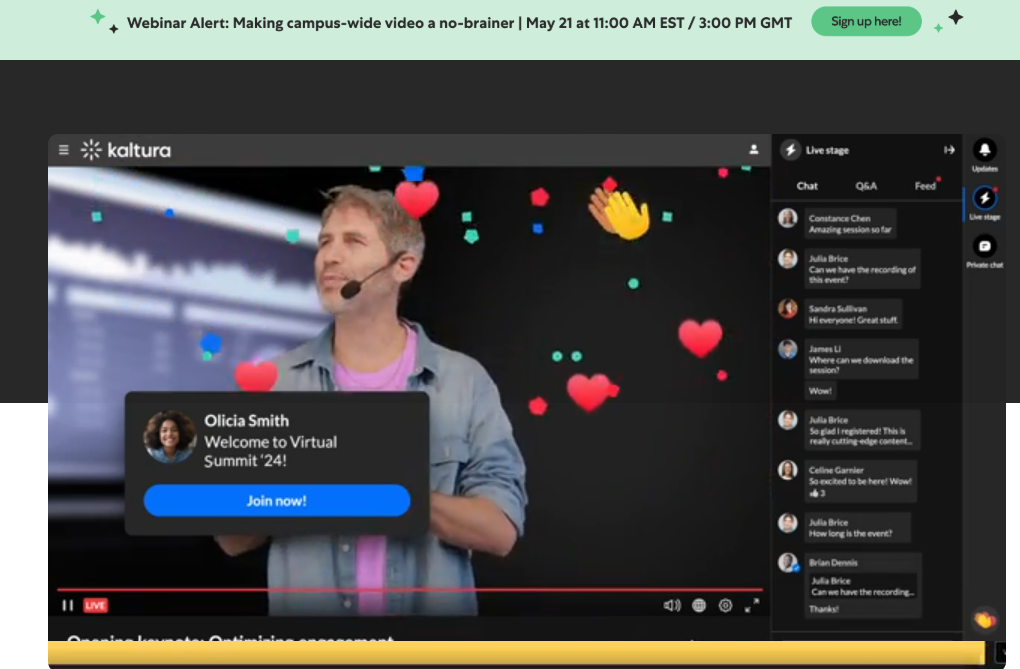
Kaltura is a video platform that is open-source and allows people to create and distribute videos. It is highly customizable, and it offers several tools for monetization, namely, live streaming, on-demand video, and interactive video that are contributed by users.
Features:
- Open-source video platform
- Interactive video tools for user engagement
- Supports live streaming and on-demand content
- Highly customizable solutions
Pros:
- Flexibility to build customized video applications
- Strong community and developer support
- Great for enterprises and the education sector
Cons:
- Complex setup and high learning curve
- Pricing can be overwhelming for smaller businesses
7. JW Player
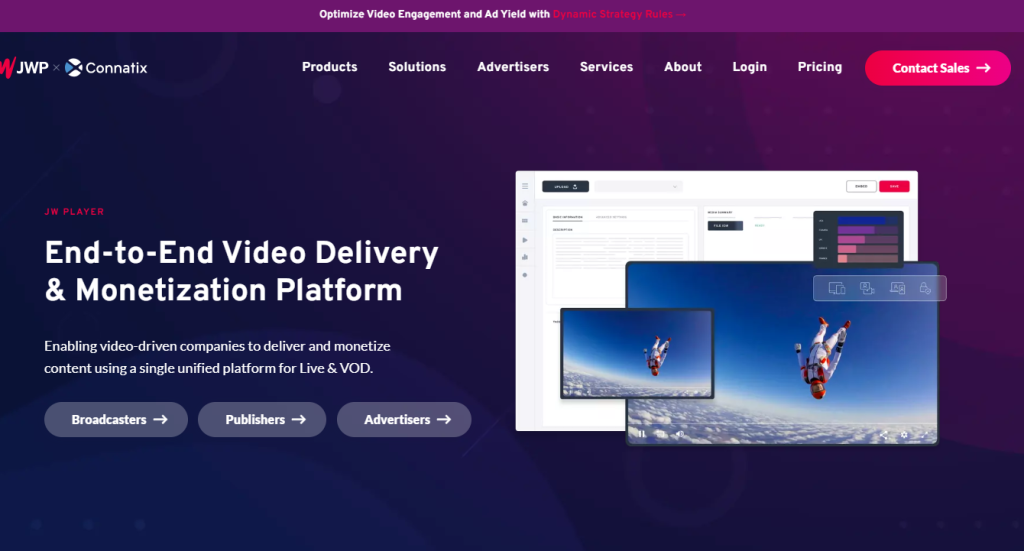
JW Player is a video player that is made and specializes in delivering high-standard video products and efficient ad revenue generation solutions. The website enjoys a video loading speed of 10.5 seconds, which is TiVo/Fast Digital Recording.
Features
- Advanced video player technology
- Ad monetization options
- Detailed video and analytics
Pros:
- Great for ad-based video monetization (AVOD)
- Fast video loading times
- Lightweight player for easy integration
Cons:
- Limited features for subscription and transactional monetization
- Basic customization options for video players
8. Uscreen
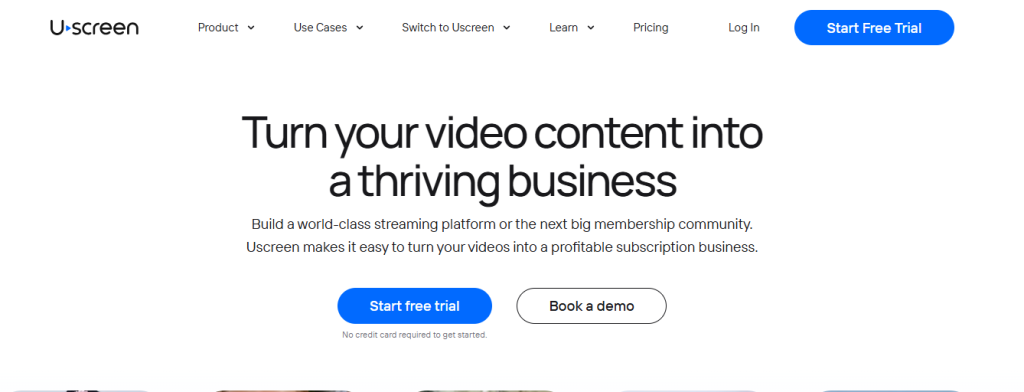
Uscreen is an SVOD and e-learning platform that enables video creators to build their own SVOD and online course platforms.
Features:
- Subscription-based monetization (SVOD)
- Community-building tools for creators
- Integration for selling courses or digital products
Pros:
- Easy for the user’s platform, fitting for the creators and educators
- Great customer support
- Particularly nice for the people’s brand and at the same time for creating a community
Cons:
- It has high costs for promoting smaller creators’ work.
- Does not offer many live streaming features.
9. Dacast
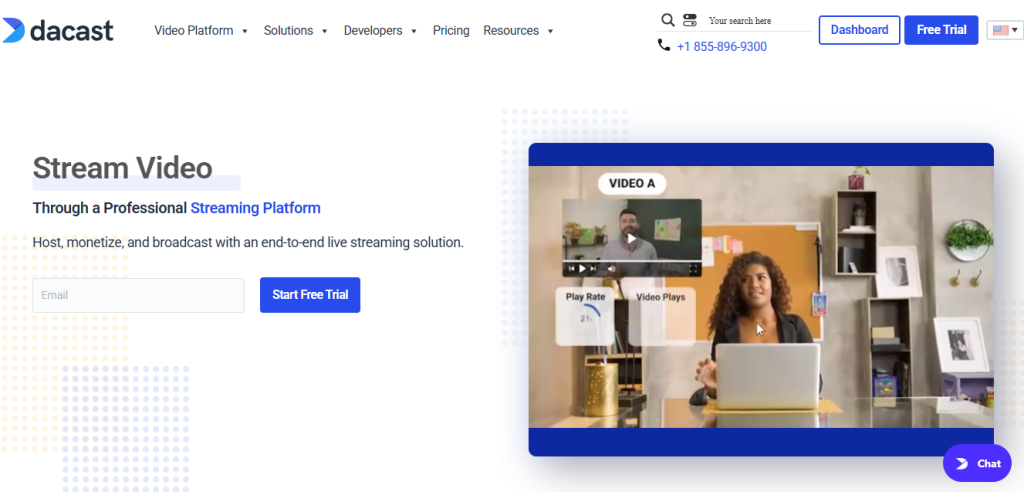
Dacast is a platform that is engaged in video streaming and monetization. It is mainly intended to be a tool for pay-per-view, subscription, and ad-based video monetization. A situation where it is most suitable is live streaming events and large corporations.
Features:
- Pay-per-view (PPV), subscription (SVOD), and ad-based monetization (AVOD)
- Live streaming capabilities
- Cloud-based video delivery
Pros:
- This is one of the best platforms for the live streaming of events
- Multiple monetization models have been made available
- It is as simple as that! platform
Cons:
- Very basic in what you can do with it
- It cannot be integrated with many third-party services
10. Muvi
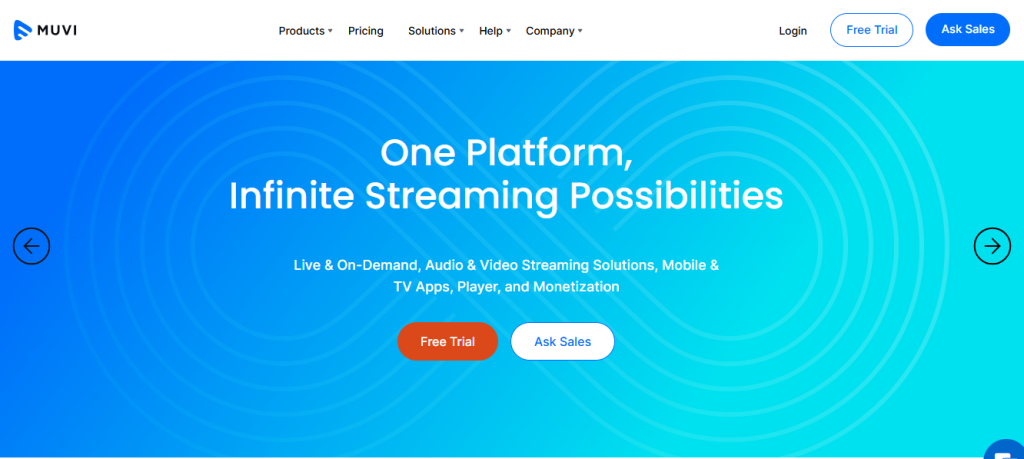
Muvi is an end-to-end, multi-functional OTT platform with all the tools to build your own video-on-demand service. Not just that, the platform supports all the widely used and popular monetization models
Features:
- Complete OTT solution
- Covers various monetization models (SVOD, AVOD, TVOD)
- Configurable
Pros:
- Enterprise-ready, suitable for large-scale businesses
- Multi-device support for streaming
- Complete video-on-demand solution
Cons:
- Expensive for smaller businesses or creators
- It can be complex for beginners
How to Select the Best Monetization Model for Your Videos in 2025
Choosing the right monetization model can significantly impact your revenue. In 2025, creators can earn via AVOD (ads), SVOD (subscriptions), TVOD (pay-per-view), or hybrid models. Selecting the model depends on your content type, audience size, and business goals.
Factors to Consider
- Audience Size & Engagement:
- Larger audiences benefit from AVOD and SVOD.
- Smaller or niche audiences may prefer membership or crowdfunding.
- Content Type & Length:
- Short-form videos → AVOD (ads)
- Long-form courses or series → SVOD (subscription)
- Revenue Goals:
- Immediate revenue → TVOD or PVOD
- Recurring revenue → SVOD or membership models
- Regional Preferences:
- Some regions prefer subscription-based platforms; others respond better to ads.
- Platform Features:
- Check if the platform supports analytics, payment gateways, and content protection.
- Include internal links to each platform: Flicknexs, Webnexs VOD, Vimeo OTT, etc.
How to Match Your Content Type with a Monetization Strategy
Live Streaming: AVOD + Donation / Membership combos
Educational Content: SVOD or Membership
Entertainment / Series / Short Clips: AVOD or TVOD
Exclusive or Premium Content: PVOD or Crowdfunding
Stat: Most of the successful creators, namely 78%, give an emphasis on mechanical monetization models and platform features, thinking they are the keys to revenue growth.
Tips to Maximize Revenue with Video Monetization in 2025
1. Optimize Content for Better Earnings
SEO for Video Titles and Descriptions
- Use targeted keywords that match your audience’s search intent.
- Design eye-catching thumbnails to boost click-through rates.
- Write power-packed intros that hook viewers in the first 10–15 seconds.
Focus on Retention and Watch Time
- Create videos that encourage viewers to watch longer, increasing total watch time.
- Higher retention signals platforms to recommend your content, attracting paid subscribers.
- Stat: Optimized metadata can increase subscription rates by 32%.
2. Leverage Multiple Monetization Streams
Combine SVOD, AVOD, and TVOD
- Subscription Video on Demand (SVOD): Users pay a monthly/yearly fee.
- Ad-Based Video on Demand (AVOD): Revenue comes from ads displayed during content.
- Transactional Video on Demand (TVOD): Users pay per video or premium content.
Hybrid Monetization Model
- Mix two or more models to diversify income sources.
- Most platforms support multiple monetization strategies, increasing profit potential.
Rich Media Suggestions:
- Table comparing revenue potential for SVOD, AVOD, TVOD, and membership:
| Monetization Model | Revenue Source | Best For |
|---|---|---|
| SVOD | Subscription fees | Loyal viewers |
| AVOD | Ads | Large audience |
| TVOD | Pay-per-view | Premium content |
The Future of Video Monetization: Trends and Insights for 2025
- AI-driven personalization will improve ad targeting and viewer engagement.
- Blockchain-based content protection and NFT ownership models are gaining traction.
- Mobile-first monetization strategies will dominate global consumption.
- Hybrid monetization platforms combining AVOD, SVOD, and TVOD will grow.
- Global audiences will demand multilingual content and regional customization.
What are the Emerging Video Monetization Trends in 2025?
Powered Personalization
- Platforms will use AI to deliver targeted ads and recommend content, increasing revenue per viewer.
- Example: Personalized ad slots on Flicknexs or YouTube can boost CTR by 25–40%.
Blockchain-Based Content Protection
- Content creators can protect IP and prevent piracy using blockchain.
- Enables secure royalty tracking and transparent revenue sharing.
NFT-Driven Video Ownership Models
- Creators can sell limited edition or premium video content as NFTs.
- Increases direct revenue and fan engagement.
Mobile-First Monetization Strategies
- Short-form content, mobile ads, and microtransactions will drive global video revenue.
- Especially impactful in regions like Southeast Asia and India.
What Predictions Can We Expect for Video Monetization in 2025?
Growth of Hybrid Monetization Platforms
- Combining AVOD, SVOD, TVOD allows creators to maximize earnings across multiple streams.
Rise of Creator-Owned Video Apps & Websites
- Independent apps enable direct subscription and membership revenue, bypassing intermediaries.
More Free Platforms for Beginners
- Entry-level platforms like Flicknexs and YouTube Shorts allow creators to start monetizing quickly.
Expansion to Global Audiences & Multilingual Content
Platforms will localize content with subtitles, dubbing, and regional ad targeting to reach new markets.
Conclusion
Video monetization continues to grow rapidly, offering creators multiple ways to earn revenue online. By 2025, video content is projected to generate over $90 billion globally, with platforms like Flicknexs, Vimeo OTT, and Webnexs leading the charge. Choosing the right monetization model—whether AVOD, SVOD, TVOD, or membership-based—is crucial for maximizing earnings and building a sustainable video business.
Key Takeaways:
- Diverse Revenue Streams: Leveraging multiple models ensures consistent income.
- Platform Selection Matters: Top platforms provide analytics, scalability, and global reach.
- Stay Updated: Monitor trends like AI-driven ad targeting and NFT ownership models to stay competitive.
Ready to start monetizing your videos? Explore Flicknexs today, subscribe to our newsletter for the latest tips, or read our guide on choosing the right monetization model to take your video business to the next level.

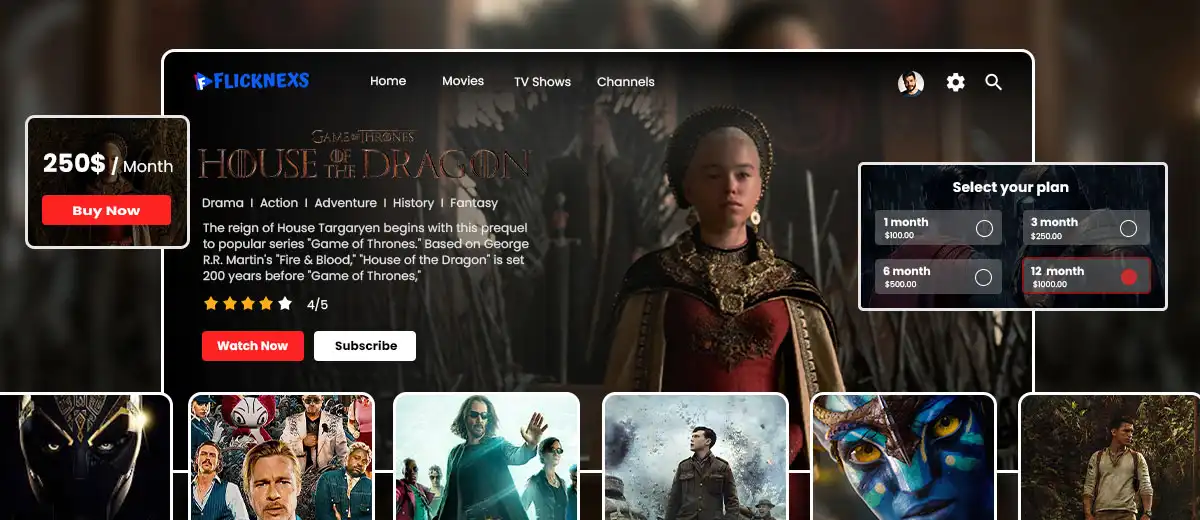

Leave a Reply